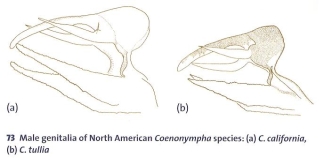The name Coenonympha is derived from the Greek koinos (shared in common) and numphe (a nymph), possibly meaning a genus containing nymphalid butterflies with widespread distribution (Emmet 1991). The generic common name "ringlets" was first used by Holland (1898) in reference to the small "ringlets" or eye spots on the wings of most species.
Ringlets are small white, orange brown, or grey butterflies with the peculiar bouncing flight pattern characteristic of many other Satyrinae.
In North America, the genus Coenonympha has been treated in a variety of ways by various authors, with the Hayden's Ringlet, C. haydeni (W.H. Edwards, 1872), being the only consistently recognized species. Some authors have considered all North American Coenonympha except haydeni to be subspecies of the European C. tullia Müller, 1764; others have recognized five species in addition to haydeni. Most recently, Layberry et al. (1998) considered all Coenonympha in Canada to be C. tullia, except for C. nipisiquit McDunnough, 1939 in coastal Quebec and New Brunswick.
We have determined that the northwestern BC Coenonympha in the C. tullia group have male genitalia that are significantly different from the C. tullia group in the rest of North America. The male genitalia of northwestern BC Coenonympha are similar to those of European C. tullia, hence we apply the name C. tullia to the northwestern BC populations. The remaining North American populations in the C. tullia group are C. california Westwood, [1851], with C. nipisiquit as a possible additional species.
North American Coenonympha species are therefore
C. haydeni, C. tullia, C. california, and possibly C. nipisiquit. C. haydeni is a clearly defined species that needs no further discussion. We do not have enough data to adequately assess the status of C. nipisiquit. C. tullia occurs in Europe, Asia, and northwestern North America. C. california occurs in North America from the Mackenzie River east to Newfoundland, and, in the west, south to California. There are about 22 species in the genus worldwide.
All ringlets hibernate as larvae; the hibernating instarvaries within as well as between populations. Larval foodplants are grasses, but whether specific grasses are chosen is unknown.
|

